The Stress–Strain State of Three-Layer Precast Flexural Concrete Enclosure Structures with the Contact Interlayers
Abstract
1. Introduction
- (i)
- The external layers made mainly of structural concrete: heavy or fine-grained concrete of class B30 and higher to provide the load-bearing of element [7,8]; expanded clay concrete of class B12.5 or higher [4,9,10]. The thickness of the external layer usually is not less than 40 mm, depending on the operating conditions of the structure and the thickness of the protective layer of the reinforcement;
- (ii)
- The internal layer of heat insulation and sound insulation is used by light concrete of low strength, such as foam concrete [11], coarse-pored concrete [12], arbolite concrete [13], polystyrene concrete [4,14,15], etc. The thickness of the middle layer is determined by the heat engineering calculation, depending on the regional location of the buildings and the purpose of the premises.
2. Materials and Methods
2.1. Experimental Studies of the Formation of a Contact Interlayer between Layers of Multilayer Concrete Elements
2.2. Development of a Theoretical Model for Calculating Multilayer Reinforced Concrete Structures during Crack Formation
- (i)
- The method of converting the composite cross-section to a homogeneous cross-section T-beam or I-beam was proposed for calculating deformations and stresses of multilayer structures with a heat-insulating layer in the middle cross-section of structures. This design scheme is starting now referred to as scheme A (Figure 4). Scheme A has not taken into account the different values of the compressive and tensile strength of concrete of the external and middle layers in the tensile and compressive zone of the cross-section.
- (ii)
- The calculation of the formation of the crack normal to the longitudinal axis of multilayer structures is made in Scheme B (Figure 5). Scheme B assumes that before cracks formation, the stresses in the compressed zone’s concrete are determined with the account of elastic deformations, and stresses reach the limit of the tensile resistance of the concrete in the stretched zone. The forces perceived by the normal cross-section in the limiting state before the formation of cracks are determined based on the following provisions:
- -
- the cross-sections after deformation remains flat, i.e., the deformations in the height of the element change according to Hook’s law;
- -
- the maximum value of elongation stretched extreme fiber of concrete is equal to ;
- -
- the stress in the concrete compressed zone is determined by the elastic deformation of the concrete in the corresponding layer;
- -
- the stresses at the boundary line of two concrete layers are different for each concrete layer due to the different modules of elasticity;
- -
- stress in the concrete stretched zones is evenly distributed within each layer and equal to the axial tensile resistance of the concrete of the external layer s Rbt1 and internal layers Rbt2, respectively;
- -
- the stresses in the reinforcement are equal to the algebraic sum of the stresses corresponding to the increment of the surrounding concrete’s deformations and the stress.
- (iii)
- Authors propose Scheme C (Figure 6) for calculating the stress and deformation during crack formation for three-layer reinforced concrete structures, with two contact interlayers between the external and internal layers. The contact interlayers have the thickness h*. It is assumed that, before cracking, the greatest elongation of the tensile concrete fiber is . If the thickness of contact interlayers h* is equal to 0, then Scheme C will revert to Scheme B (without accounting for the contact interlayer effect). The properties and characteristics of the contact interlayer’s concrete are designated as: compressive strength Rb*, tensile strength Rbt*, and the modulus of elasticity Eb*; thickness h*.
- and are the strain of materials in the top and bottom layers of the neutral axis;
- and are the compressive and tensile stress of concrete in the top and bottom layers of the neutral axis;
- is the tensile stress of steel;
- is the compressive stress by shrinkage of concrete;
- and are elastic modulus of the concrete and steel;
- is thickness of external layers;
- b and h are width and height of cross-section;
- , and , are the ultimate compressive and tensile stress of concrete in external and internal layers.
2.3. Experiment for Determination of Stress and Deformation of Flexural Three-Layer Reinforced Concrete Beams During Cracking
3. Results and Discussion
3.1. Test Results of The Study of the Formation and Geometric Characteristics of the Contact Interlayer of Multilayer Reinforced Concrete Structures
3.2. The Calculation of Multilayer Reinforced Concrete Structures with the Contact Interlayer in the Case of Cracking
3.3. Comparison of Experimental and Calculated Crack Propagation Moment for Multilayer Reinforced Concrete Structures
4. Conclusions
- (1).
- In the manufacturing of reinforced multilayer precast concrete structures with different concrete types in the external and internal layers, a contact interlayer thickness up to 1 cm is formed between them.
- (2).
- It was shown that the contact interlayers between the external and internal layers improve the structural stability and monolithic cross-section of multilayer reinforced concrete structures.
- (3).
- The method for calculating the stress–strain states for the three-layer reinforced concrete structure with the contact interlayers between layers of different types of concretes was proposed and developed.
- (4).
- The results of the calculated crack propagation moment for three-layer reinforced concrete beams by the proposed method with accounting the contact interlayers is 9.1% greater than that obtained by the scheme of the cross-section conversion. These results are near to experimental results than other theoretical models without taking into account the contact interlayer.
Author Contributions
Funding
Institutional Review Board Statement
Informed Consent Statement
Data Availability Statement
Acknowledgments
Conflicts of Interest
References
- Korol, E.; Tho, V.D.; Hoang, N.H. Analysis of the effectiveness of thermal insulation of a multi-layer reinforced concrete slab using a layer of concrete with low thermal conductivity under the climatic conditions of Vietnam. MATEC Web Conf. 2018, 251, 04026. [Google Scholar] [CrossRef][Green Version]
- Halwatura, R.U.; Jayasinghe, M.T.R. Thermal performance of insulated roof slabs in tropical climates. Energy Build. 2008, 40, 1153–1160. [Google Scholar] [CrossRef]
- Santamouris, M. Analyzing the heat island magnitude and characteristics in one hundred Asian and Australian cities and regions. Sci. Total Environ. 2015, 512, 582–598. [Google Scholar] [CrossRef]
- Korol, E.; Berlinova, M. Calculation of multilayer enclosing structures with middle layer of polystyrene concrete. MATEC Web Conf. 2018, 193, 03020. [Google Scholar] [CrossRef][Green Version]
- Mavromatidis, L.E.; Michel, P.; El Mankibi, M.; Santamouris, M. Study on transient heat transfer through multilayer thermal insulation: Numerical analysis and experimental investigation. Build. Simul. 2010, 3, 279–294. [Google Scholar] [CrossRef]
- Belyaev, A.; Nesvetaev, G.; Mailyan, D. The Issues of Energy-Efficiency Increase of Three-Layer Reinforced Concrete Plate Constructions. Adv. Intell. Syst. Comput. 2018, 692, 529–535. [Google Scholar] [CrossRef]
- Tho, V.D.; Kopol, E.A. Influence of contact layers on the crack resistance of bent three-layer structures. Vestn. MGSU 2020, 15, 988–998. [Google Scholar] [CrossRef]
- Lam, T.V.; Vu, D.T.; Dien, V.K.; Bulgakov, B.I.; Korol, E.A. Properties and thermal insulation performance of lightweight concrete. Mag. Civ. Eng. 2018, 84, 173–191. [Google Scholar] [CrossRef]
- Vilguts, A.; Serdjuks, D.; Pakrastins, L. Design Methods of Elements from Cross-laminated Timber Subjected to Flexure. Procedia Eng. 2015, 117, 10–19. [Google Scholar] [CrossRef]
- Korol, E.A. The choice of the rational parameters of three-layer reinforced concrete enclosing structures with the monolithic bond of layers by computer simulation. IOP Conf. Ser. Mater. Sci. Eng. 2018, 456, 012075. [Google Scholar] [CrossRef]
- Amran, Y.H.M.; Rashid, R.S.M.; Hejazi, F.; Abang Ali, A.A.; Safiee, N.A.; Bida, S.M. Structural Performance of Precast Foamed Concrete Sandwich Panel Subjected to Axial Load. KSCE J. Civ. Eng. 2017, 22, 1179–1192. [Google Scholar] [CrossRef]
- Diamond, S. Aspects of concrete porosity revisited. Cem. Concr. Res. 1999, 29, 1181–1188. [Google Scholar] [CrossRef]
- Clouston, P.; Bathon, L.A.; Schreyer, A. Shear and Bending Performance of a Novel Wood–Concrete Composite System. J. Struct. Eng. 2005, 131, 1404–1412. [Google Scholar] [CrossRef]
- Fernando, P.L.N.; Jayasinghe, M.T.R.; Jayasinghe, C. Structural feasibility of Expanded Polystyrene (EPS) based lightweight concrete sandwich wall panels. Constr. Build. Mater. 2017, 139, 45–51. [Google Scholar] [CrossRef]
- Wu, Z.; Chen, B.; Liu, N. Fabrication and compressive properties of expanded polystyrene foamed concrete: Experimental research and modeling. J. Shanghai Jiaotong Univ. Sci. 2013, 18, 61–69. [Google Scholar] [CrossRef]
- Shendy, M.E. A comparative study of LECA concrete sandwich beams with and without core reinforcement. Cem. Concr. Compos. 1991, 13, 143–149. [Google Scholar] [CrossRef]
- Shams, A.; Horstmann, M.; Hegger, J. Experimental investigations on Textile-Reinforced Concrete (TRC) sandwich sections. Compos. Struct. 2014, 118, 643–653. [Google Scholar] [CrossRef]
- Aydogdu, M. Vibration analysis of cross-ply laminated beams with general boundary conditions by Ritz method. Int. J. Mech. Sci. 2005, 47, 1740–1755. [Google Scholar] [CrossRef]
- Andreev, V.I.; Turusov, R.A.; Tsybin, N.Y. Application of the Contact Layer in the Solution of the Problem of Bending the Multilayer Beam. Procedia Eng. 2016, 153, 59–65. [Google Scholar] [CrossRef]
- Turusov, R.A.; Andreev, V.I.; Tsybin, N.Y. The contact layer stiffness influence assessment on the stress-strain state of a multilayer beam. Architecture, design and reconstruction of architectural heritage (2020). IOP Conf. Ser. Mater. Sci. Eng. 2020, 913. [Google Scholar] [CrossRef]
- Gara, F.; Ragni, L.; Roia, D.; Dezi, L. Experimental behaviour and numerical analysis of floor sandwich panels. Eng. Struct. 2012, 36, 258–269. [Google Scholar] [CrossRef]
- Tho, V.D.; Korol, E.A. Influence of geometrical parameters of the cross section, strength and deformability of the materials used on stressstrain state of three-layered reinforced concrete. IOP Conf. Ser. Mater. Sci. Eng. 2019, 661, 012121. [Google Scholar] [CrossRef]
- Benayoune, A.; Samad, A.; Trikha, D.N.; Ali, A.A.; Ellinna, S.H.M. Flexural behaviour of pre-cast concrete sandwich composite panel—Experimental and theoretical investigations. Constr. Build. Mater. 2008, 22, 580–592. [Google Scholar] [CrossRef]
- Gara, F.; Ragni, L.; Roia, D.; Dezi, L. Experimental tests and numerical modelling of wall sandwich panels. Eng. Struct. 2012, 37, 193–204. [Google Scholar] [CrossRef]
- Yue, Z.; Xiao, H. Generalized Kelvin Solution based boundary element method for crack problems in multilayered solids. Eng. Anal. Bound. Elem. 2002, 26, 691–705. [Google Scholar] [CrossRef]
- Marčiukaitis, G.; Juknevičius, L. Influence of the Internal Layer Cracks on the Cracking of Flexural Three-Layer Concrete Members. J. Civ. Eng. Manag. 2002, 8, 153–158. [Google Scholar] [CrossRef]
- Olmedo-Zazo, F.I.; Carrillo-Alonso, L.; Valivonis, J.; Martínez-Pérez, I. Influence of the construction processing the multilayer lightweight concrete beam behaviour. Dyna 2019, 94, 395–400. [Google Scholar] [CrossRef]
- Horska, A.; Fladr, J.; Kohoutkova, A. Testing of multi-layer concrete-based structures loaded by contact blast. In Proceedings of the 12th fib International Phd Symposium in Civil Engineering, Czech Technical University in Prague, Prague, Czech Republic, 29–31 August 2018; pp. 427–432. [Google Scholar]
- Gao, Y.; De Schutter, G.; Ye, G.; Tan, Z.; Wu, K. The ITZ microstructure, thickness and porosity in blended cementitious composite: Effects of curing age, water to binder ratio and aggregate content. Compos. Part B Eng. Struct. 2014, 60, 1–13. [Google Scholar] [CrossRef]
- Hilal, A.A. Microstructure of Concrete. High Perform. Concr. Technol. Appl. 2016. [Google Scholar] [CrossRef]
- Andreev, V.I.; Turusov, R.A.; Tsybin, N.Y. The contact layer method in calculating of the shear compounds. RSP 2017–26th R-S-P Seminar 2017 Theoretical Foundation Civil Engineering. MATEC Web Conf. 2017, 117. [Google Scholar] [CrossRef]
- Kolchunov, V.I.; Dem’yanov, A.I. The modeling method of discrete cracks and rigidity in reinforced concrete. Mag. Civ. Eng. 2019, 88, 60–69. [Google Scholar] [CrossRef]
- Tsybin, N.; Turusov, R.; Andreev, V.; Kolesnikov, A. Stress-strain state of a three-layer rod. Comparison of the results of analytical and numerical calculations with the experiment. MATEC Web Conf. 2018, 196, 01057. [Google Scholar] [CrossRef][Green Version]
- Morozov, N.F.; Tovstik, P.Y. Bending of a two-layer beam with non-rigid contact between the layers. J. Appl. Math. Mech. 2011, 75, 77–84. [Google Scholar] [CrossRef]
- Foraboschi, P. Three-layered plate: Elasticity solution. Compos. Part B Eng. 2014, 60, 764–776. [Google Scholar] [CrossRef]
- Hadi, M.N.S.; Bodhinayake, B.C. Non-linear finite element analysis of flexible pavements. Adv. Eng. Softw. 2003, 34, 657–662. [Google Scholar] [CrossRef]
- Carrera, E. A refined multilayered finite-element model applied to linear and non-linear analysis of sandwich plates. Compos. Sci. Technol. 1998, 58, 1553–1569. [Google Scholar] [CrossRef]
- Korolev, A.S.; Zyrianov, F.A. Layer model of the cement composites deformation in the reinforced masonry structures. Constr. Unique Build. Struct. 2020, 92, 9202. [Google Scholar] [CrossRef]
- Korolev, A.; Mishnev, M.; Zherebtsov, D.; Vatin, N.I.; Karelina, M.; Arjmand, M. Polymers under Load and Heating Deformability: Modelling and Predicting. Polymer 2021, 13, 428. [Google Scholar] [CrossRef]
- Laskar, S.M.; Reja, H.; Talukdar, S. Behaviour of cold jointed and layered Portland cement–alkali-activated reinforced concrete beams. Asian J. Civ. Eng. 2020, 21, 1193–1204. [Google Scholar] [CrossRef]
- Lassnig, A.; Putz, B.; Hirn, S.; Többens, D.M.; Mitterer, C.; Cordill, M.J. Adhesion evaluation of thin films to dielectrics in multilayer stacks: A comparison of four-point bending and stressed overlayer technique. Mater. Des. 2021, 200, 109451. [Google Scholar] [CrossRef]
- Funari, M.F.; Spadea, S.; Fabbrocino, F.; Luciano, R. A Moving Interface Finite Element Formulation to Predict Dynamic Edge Debonding in FRP-Strengthened Concrete Beams in Service Conditions. Fibers 2020, 8, 42. [Google Scholar] [CrossRef]
- Funari, M.F.; Greco, F.; Lonetti, P. A cohesive finite element model based ALE formulation for z-pins reinforced multilayered composite beams. Procedia Struct. Integr. 2016, 2, 452–459. [Google Scholar] [CrossRef]
- Funari, M.F.; Lonetti, P. Initiation and evolution of debonding phenomena in layered structures. Theor. Appl. Fract. Mech. 2017, 92, 133–145. [Google Scholar] [CrossRef]
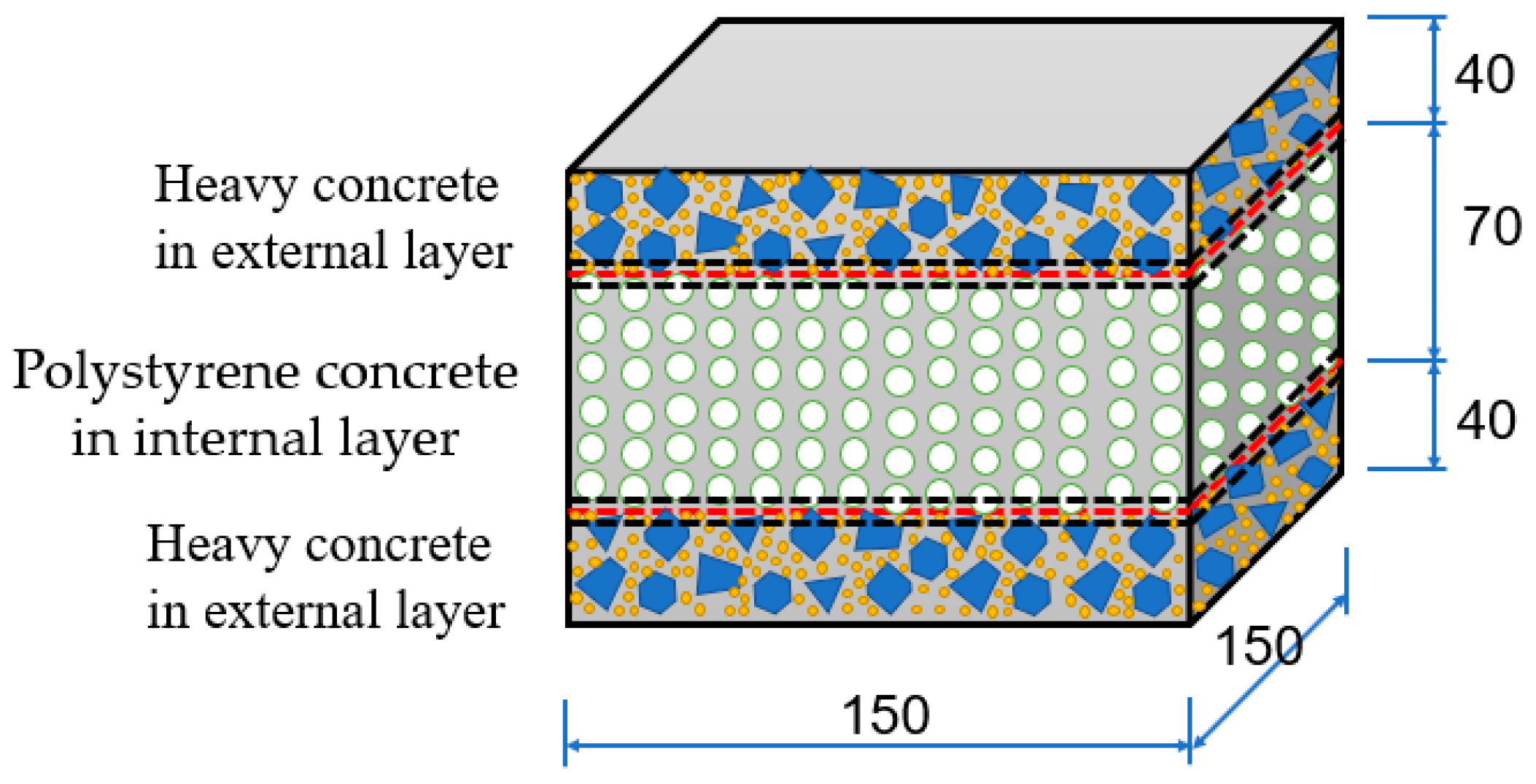

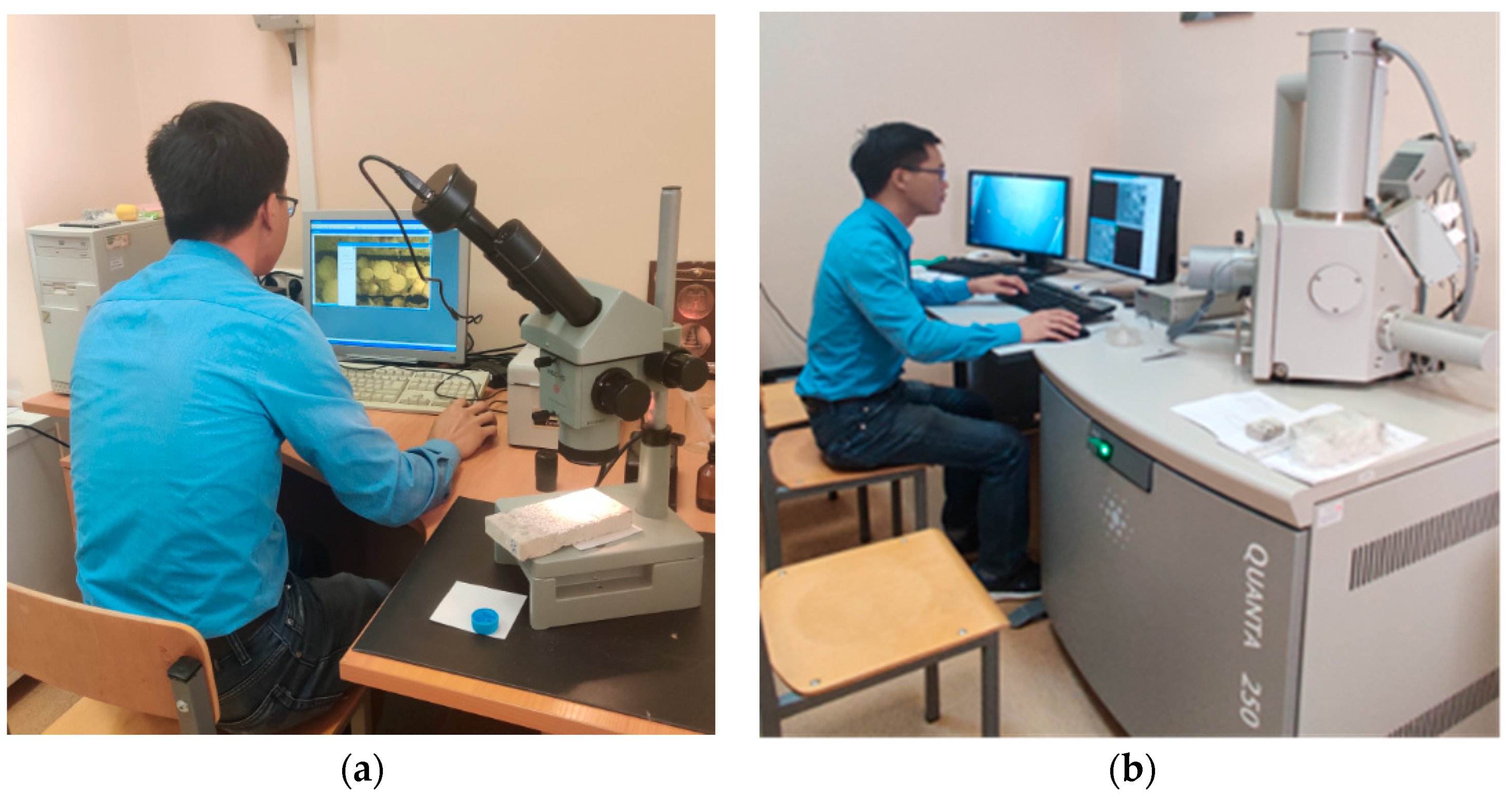




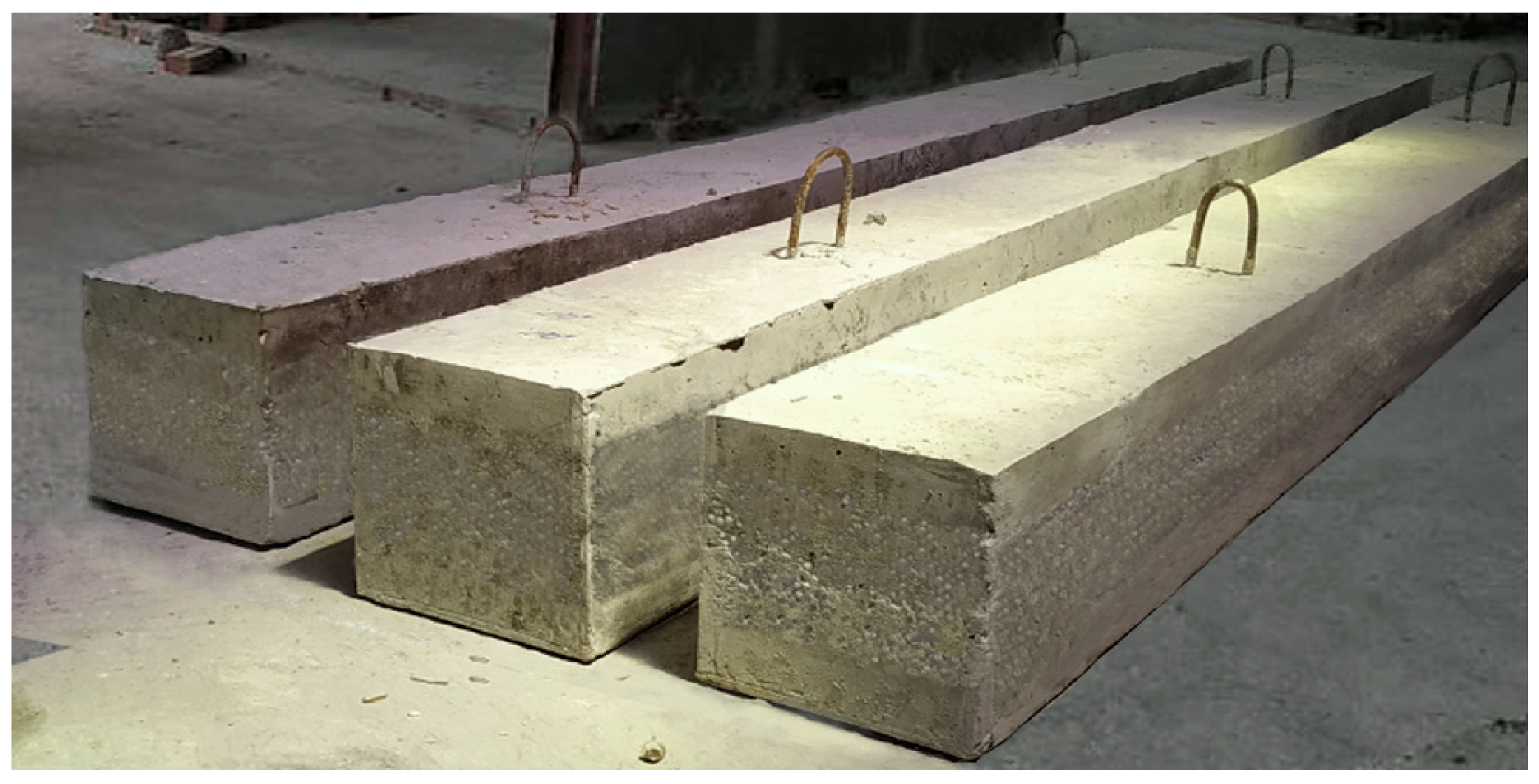
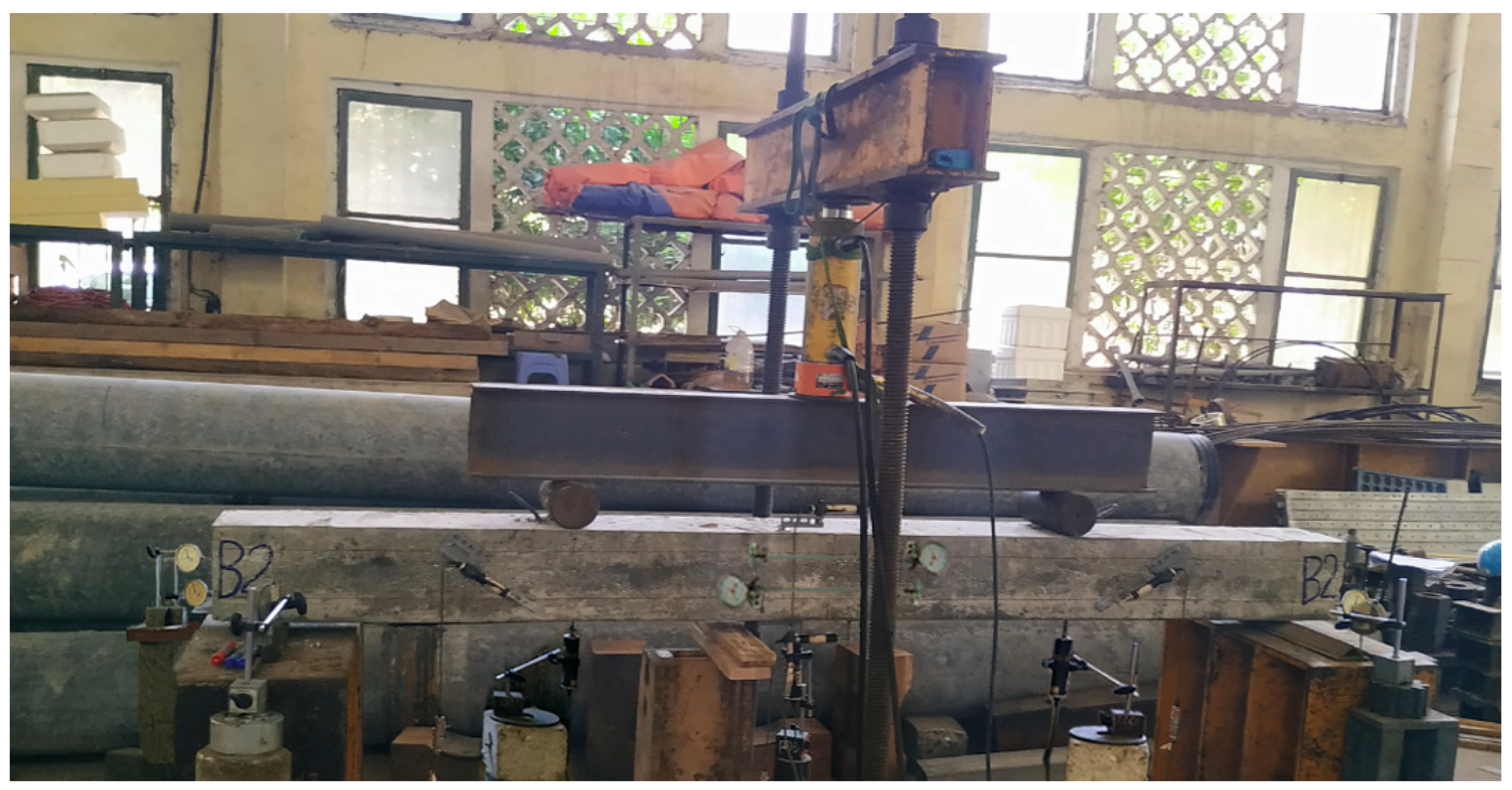
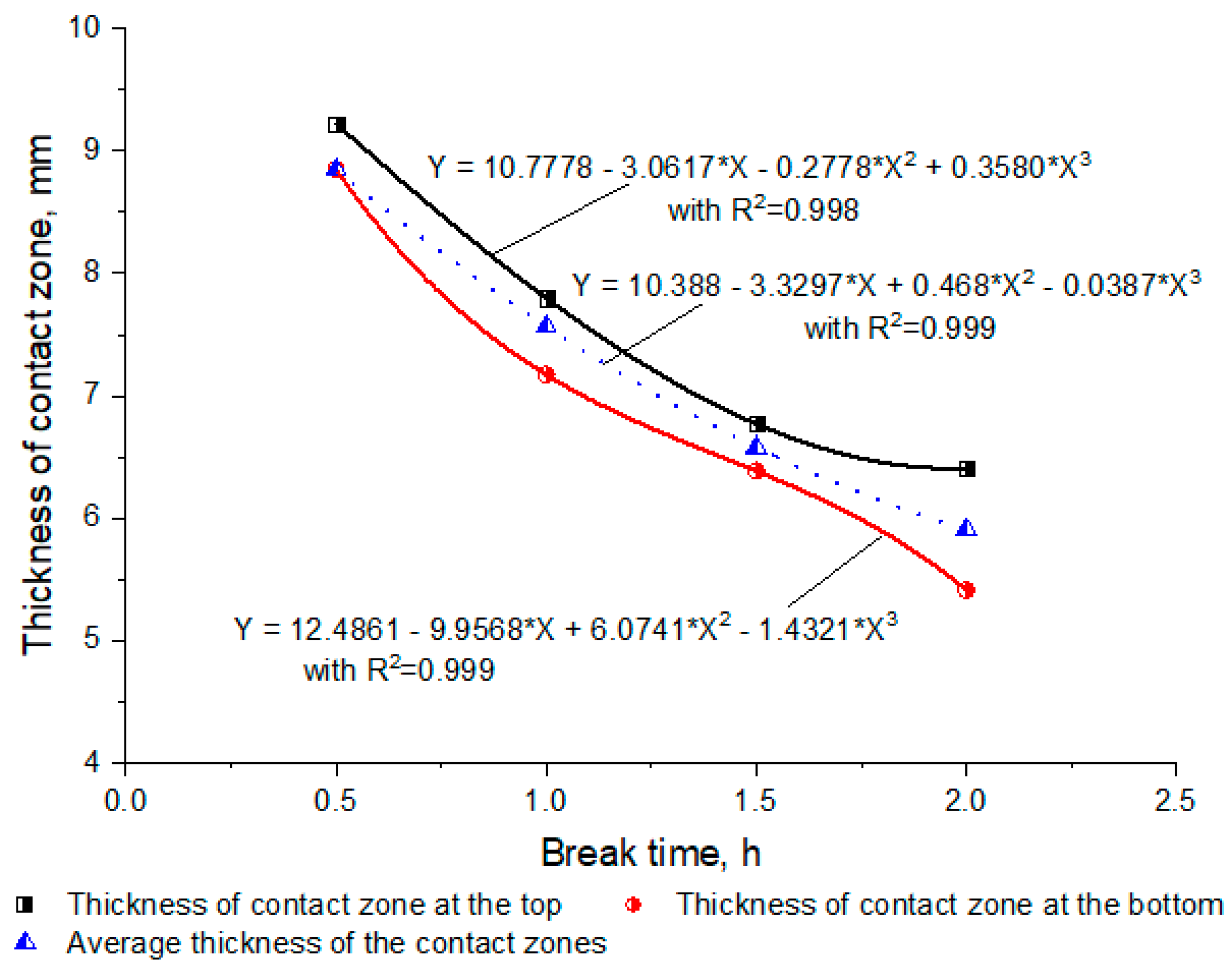
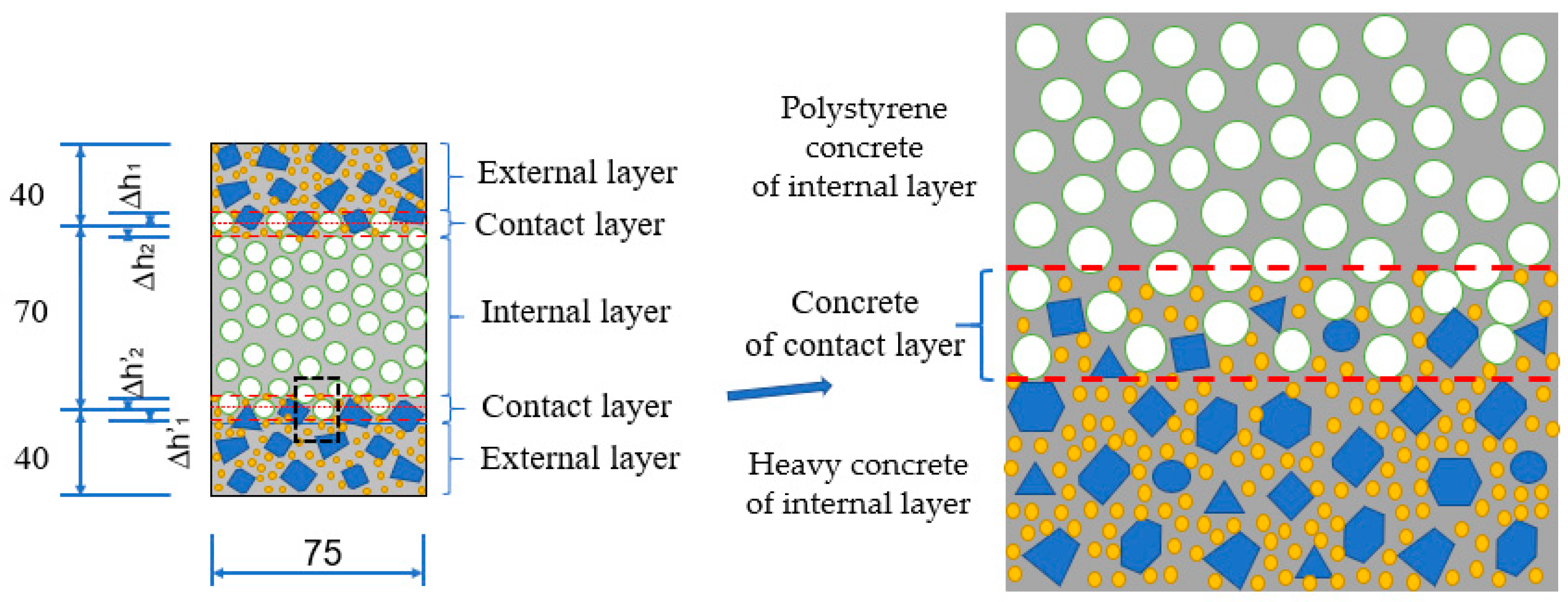
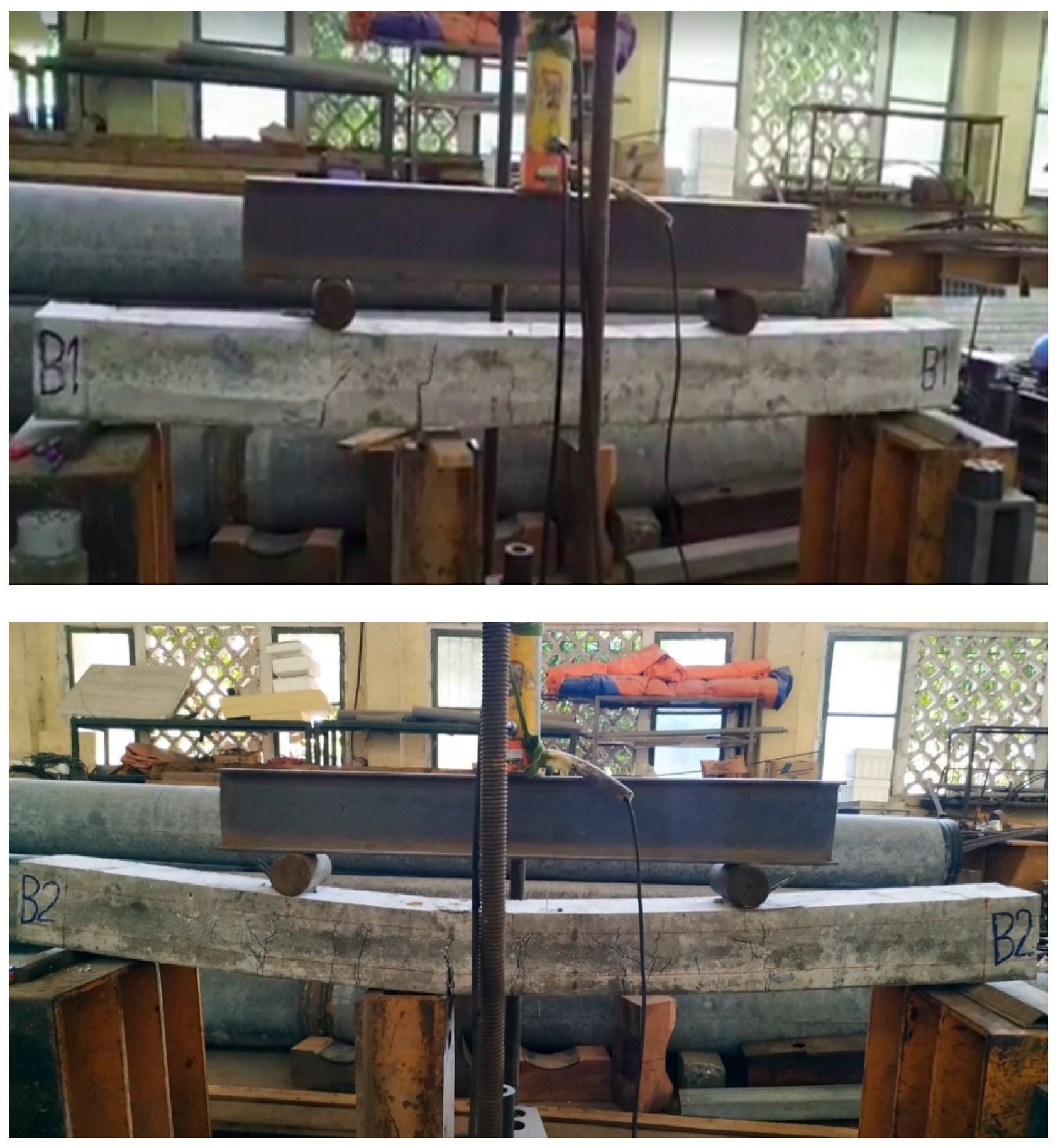
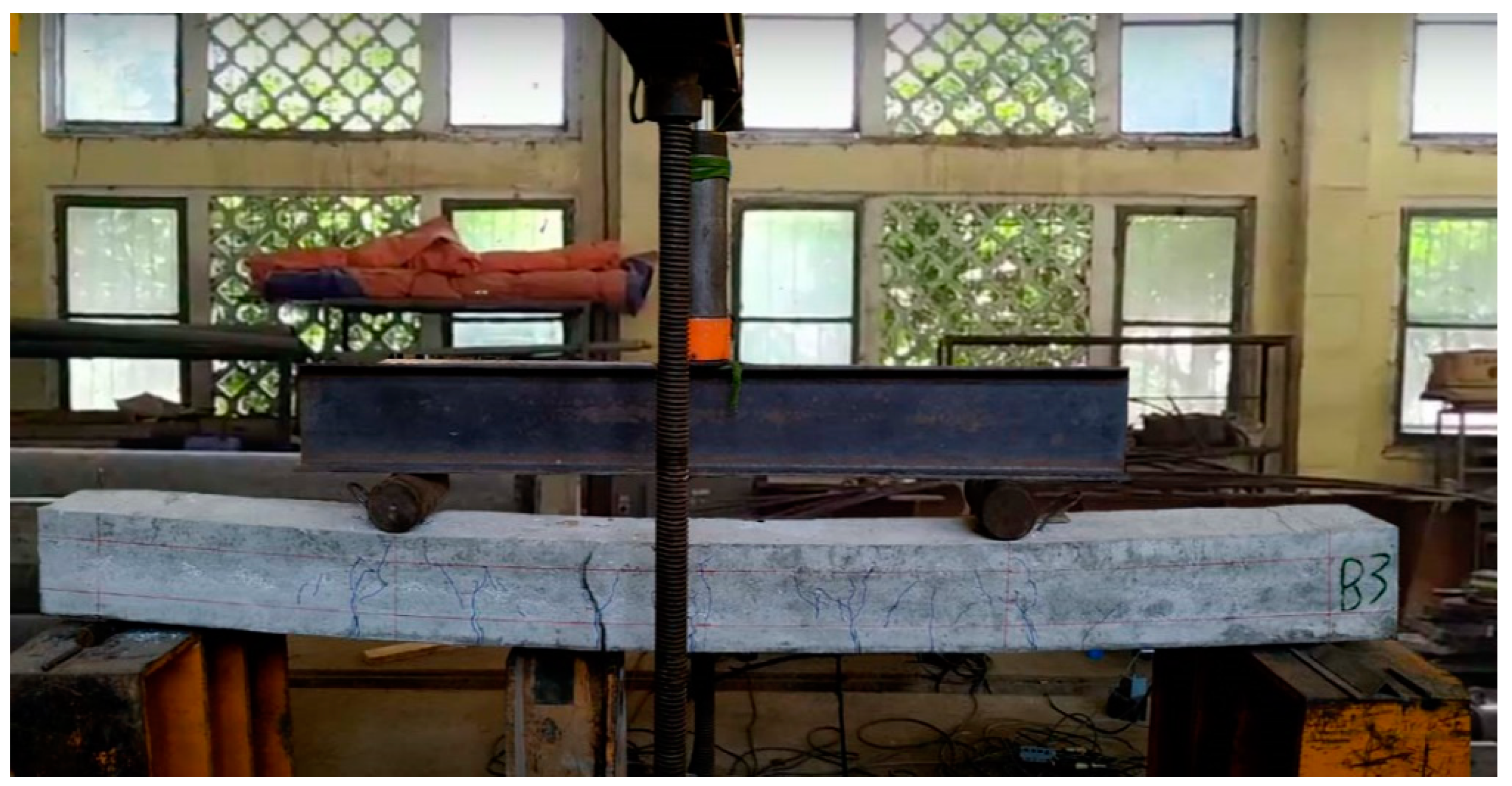
| Class of Concrete | Density, kg/m3 | Cement (M400), kg | Water, l | Crushed Limestone, from 0.5 to 1 cm in Size, kg | Sand, from 0 to 2 mm in Size, kg | Expanded Polystyrene Granules EPS, from 2 to 5 mm in Size, kg | Chemical Additives, SilkRoad SR-5000F,
g |
|---|---|---|---|---|---|---|---|
| B1 | 346 | 330 | 105 | - | - | 0.69 | 710 |
| B25 | 2376 | 439 | 195 | 1121 | 621 | - | - |
| Density, kg/m3 | Compressive Strength at Different Ages of Hardening, MPa | Ultimate Tensile Strength in Bending at the Age of 28 Days, MPa | Average Thermal Conductivity Dry, W/(m °C) | ||||
|---|---|---|---|---|---|---|---|
| 1 Day | 3 Days | 7 Days | 14 Days | 28 Days | |||
| 2376 | 10.56 | 17.30 | 20.96 | 24.71 | 33.15 | 3.29 | 1.25 |
| Density, kg/m3 | Compressive Strength at Different Ages of Hardening, MPa | Ultimate Tensile Strength in Bending at the Age of 28 Days, MPa | Average Thermal Conductivity Dry, W/(m °C) | ||||
|---|---|---|---|---|---|---|---|
| 1 Day | 3 Days | 7 Days | 14 Days | 28 Days | |||
| 346 | 0.37 | 0.45 | 0.63 | 0.75 | 0.83 | 0.29 | 0.135 |
| No of Beams | Heavy Concrete | Polystyrene Concrete | ||||||
|---|---|---|---|---|---|---|---|---|
| Rm | Rb | Rbt | Eb·10−3 | Rm | Rb | Rbt | Eb·10−3 | |
| MPa | ||||||||
| 1, 2, 3 | 33.15 | 18.06 | 2.56 | 33.2 | 0.83 | 0.75 | 0.23 | 0.57 |
| No of Beams | Diameter and Class of Steel | As, cm2 | fy, MPa | fu, MPa | Es 10−3, MPa |
|---|---|---|---|---|---|
| 1–3 | Ø8 C-III | 0.503 | 390 | 563 | 206 |
| Series of Samples | Location of the Contact Zone | Thickness of Part Contact Zones for Samples | Average Thickness of the Contact Zone Section, mm | Average Thickness of the Contact Zone, mm | |||||||||
|---|---|---|---|---|---|---|---|---|---|---|---|---|---|
| 1 | 2 | 3 | h* | ||||||||||
| 0.5 | Top | ∆h1 | 4.5 | 5.0 | 5.5 | 4.5 | 4.7 | 4.9 | 4.0 | 4.5 | 4.5 | 4.8 | 9.5 |
| ∆h2 | 4.5 | 4.9 | 4.7 | 4.5 | 4.4 | 4.1 | 5.0 | 4.5 | 4.5 | 4.7 | |||
| Bottom | ∆h1’ | 3.6 | 4.1 | 5.0 | 4.8 | 4.5 | 4.2 | 4.3 | 5.3 | 5.3 | 4.7 | 9.2 | |
| ∆h2’ | 4.4 | 4.4 | 4.1 | 3.9 | 4.3 | 4.1 | 4.3 | 4.5 | 4.7 | 4.5 | |||
| 1 | Top | ∆h1 | 3.6 | 3.4 | 3.4 | 3.9 | 4.0 | 4.0 | 4.2 | 3.8 | 2.9 | 3.9 | 8.1 |
| ∆h2 | 3.9 | 4.2 | 4.3 | 3.9 | 4.0 | 4.0 | 4.2 | 4.5 | 4.5 | 4.2 | |||
| Bottom | ∆h1’ | 4.3 | 4.0 | 3.8 | 3.6 | 3.5 | 3.5 | 3.8 | 4.2 | 4.2 | 3.9 | 7.6 | |
| ∆h2’ | 3.3 | 3.3 | 3.2 | 3.9 | 4.0 | 4.1 | 3.5 | 3.3 | 3.4 | 3.7 | |||
| 1.5 | Top | ∆h1 | 3.5 | 3.0 | 2.9 | 3.4 | 3.6 | 3.4 | 3.3 | 3.2 | 3.1 | 3.3 | 6.8 |
| ∆h2 | 3.8 | 4.0 | 3.9 | 3.3 | 3.4 | 3.6 | 3.3 | 3.2 | 3.1 | 3.5 | |||
| Bottom | ∆h1’ | 3.4 | 3.1 | 3.7 | 3.3 | 3.3 | 3.9 | 3.1 | 3.4 | 3.3 | 3.4 | 6.4 | |
| ∆h2’ | 3.0 | 3.1 | 3.2 | 3.3 | 3.3 | 3.4 | 3.1 | 3.2 | 3.2 | 3.2 | |||
| 2 | Top | ∆h1 | 3.0 | 3.1 | 3.3 | 3.3 | 3.2 | 3.3 | 3.4 | 2.8 | 2.2 | 3.0 | 6.3 |
| ∆h2 | 3.0 | 3.1 | 3.1 | 3.1 | 3.2 | 3.3 | 3.4 | 4.0 | 4.5 | 3.3 | |||
| Bottom | ∆h1’ | 2.8 | 2.7 | 2.6 | 2.6 | 2.5 | 2.8 | 2.7 | 2.7 | 2.8 | 2.7 | 5.5 | |
| ∆h2’ | 2.3 | 2.7 | 2.9 | 2.3 | 2.2 | 2.0 | 3.3 | 3.6 | 3.7 | 2.8 | |||
| Average thickness of the contact zone section, mm | |||||||||||||
| Average thickness of the contact zone, mm | |||||||||||||
| Thickness of Contact Interlayers, h*, cm | The Crack Propagation Moment, Mcrc × 10−4, kN m | |||||
|---|---|---|---|---|---|---|
| Scheme A (Mcrc{A}) | Scheme B (Mcrc{B}) | Scheme C (Mcrc{C}) | %(Mcrc{B}) /(Mcrc{A}) | %(Mcrc{C}) /(Mcrc{A}) | %(Mcrc{C}) /(Mcrc{B}) | |
| 0 | 4.351 | 4.672 | 4.672 | 107.40% | 107.40% | 100.00% |
| 0.1 | 4.351 | 4.672 | 4.683 | 107.40% | 107.65% | 100.23% |
| 0.2 | 4.351 | 4.672 | 4.694 | 107.40% | 107.90% | 100.47% |
| 0.3 | 4.351 | 4.672 | 4.705 | 107.40% | 108.15% | 100.70% |
| 0.4 | 4.351 | 4.672 | 4.716 | 107.40% | 108.40% | 100.93% |
| 0.5 | 4.351 | 4.672 | 4.727 | 107.40% | 108.66% | 101.16% |
| 0.6 | 4.351 | 4.672 | 4.737 | 107.40% | 108.91% | 101.40% |
| 0.7 | 4.351 | 4.672 | 4.748 | 107.40% | 109.16% | 101.63% |
| 0.8 | 4.351 | 4.672 | 4.759 | 107.40% | 109.41% | 101.87% |
| 0.9 | 4.351 | 4.672 | 4.770 | 107.40% | 109.66% | 102.10% |
| 1 | 4.351 | 4.672 | 4.781 | 107.40% | 109.91% | 102.33% |
| No the Samples | Name of Beam Samples | The Crack Propagation Moment, Mcrc × 10−4, kN m | |||||||
|---|---|---|---|---|---|---|---|---|---|
| The Results of the Test | The Average Values of the Test | By Using the Scheme A (Mcrc{A}) | By Using the Scheme B (Mcrc{B}) | By Using the Proposed Scheme C
(Mcrc{C}) | |||||
| Mcrc{exp} | Mcrc{A} | %(Mcrc{A}) /Mcrc{exp} | Mcrc{B} | %(Mcrc{B}) /Mcrc{exp} | Mcrc{C} | %(Mcrc{C}) /Mcrc{exp} | |||
| 1 | B-1 | 4.81 | 4.84 | 4.35 | 89.88% | 4.67 | 96.50% | 4.71 | 97.31% |
| 2 | B-2 | 4.83 | 4.35 | 89.88% | 4.67 | 96.50% | 4.73 | 97.73% | |
| 3 | B-3 | 4.88 | 4.35 | 89.88% | 4.67 | 96.50% | 4.76 | 98.34% | |
Publisher’s Note: MDPI stays neutral with regard to jurisdictional claims in published maps and institutional affiliations. |
© 2021 by the authors. Licensee MDPI, Basel, Switzerland. This article is an open access article distributed under the terms and conditions of the Creative Commons Attribution (CC BY) license (http://creativecommons.org/licenses/by/4.0/).
Share and Cite
Tho, V.D.; Korol, E.A.; Vatin, N.I.; Duc, H.M. The Stress–Strain State of Three-Layer Precast Flexural Concrete Enclosure Structures with the Contact Interlayers. Buildings 2021, 11, 88. https://doi.org/10.3390/buildings11030088
Tho VD, Korol EA, Vatin NI, Duc HM. The Stress–Strain State of Three-Layer Precast Flexural Concrete Enclosure Structures with the Contact Interlayers. Buildings. 2021; 11(3):88. https://doi.org/10.3390/buildings11030088
Chicago/Turabian StyleTho, Vu Dinh, Elena Anatolyevna Korol, Nikolai Ivanovich Vatin, and Hoang Minh Duc. 2021. "The Stress–Strain State of Three-Layer Precast Flexural Concrete Enclosure Structures with the Contact Interlayers" Buildings 11, no. 3: 88. https://doi.org/10.3390/buildings11030088
APA StyleTho, V. D., Korol, E. A., Vatin, N. I., & Duc, H. M. (2021). The Stress–Strain State of Three-Layer Precast Flexural Concrete Enclosure Structures with the Contact Interlayers. Buildings, 11(3), 88. https://doi.org/10.3390/buildings11030088







